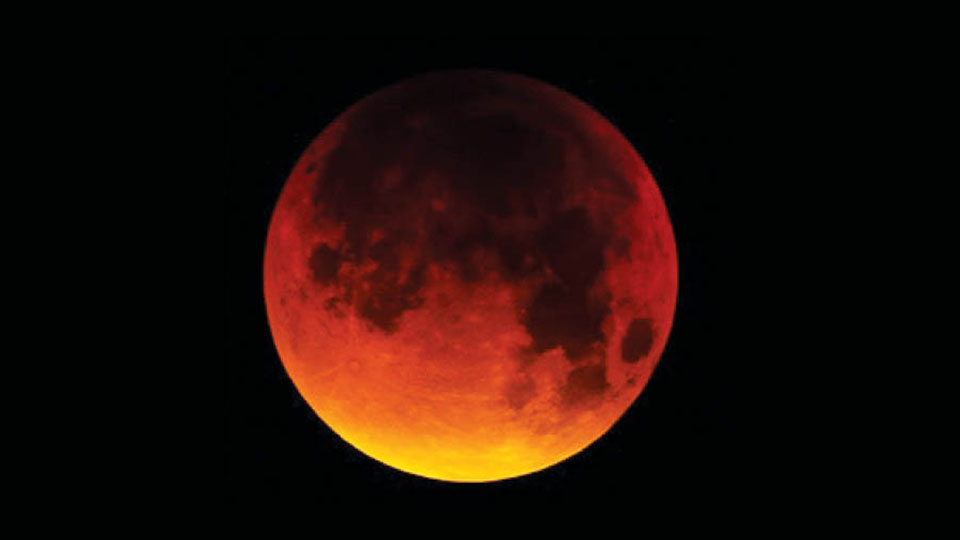By Dr. S.A. Mohan Krishna, Amateur Astronomer
None can forget the mesmerising Supermoon, Bloodmoon Total Lunar Eclipse that occurred on Jan. 31, 2018! This astronomical occurrence has been memorable and millions witnessed this spectacular spectacle. In the same way, during July 27 – 28, 2019, Indians were really fortunate to witness a longest duration ‘Total Lunar Eclipse’ of this century. On Nov. 8, Mysureans can see to a penumbral lunar eclipse. From Mysuru, Lunar Eclipse can be seen from 5.54 pm to 6.19 pm tomorrow. The total duration of the eclipse at Mysuru will be about 25 minutes. Eclipse will be visible in the region covering South America, North America, Australia, Asia, the North Atlantic Ocean and the Pacific Ocean. The places from where the beginning of the umbral phase is visible at the time of moonset are western parts of Argentina, Chile, Bolivia, western parts of Brazil and the North Atlantic Ocean.
The places from where the ending of the umbral phase is visible at the time of moonrise are the Indian Ocean, India, Pakistan, Afghanistan, Kazakhstan, Uzbekistan and Eastern Russia.
The eclipse is visible from all places of India at the time of moonrise. However, the beginning of the partial and total phases of the eclipse is not visible from any place of India as the phenomena will be in progress before moonrise.
Ending of both the total and the partial phases is visible from the eastern parts of the country. Only the ending of the partial phase is visible from the rest parts of the country.
Lunar Eclipses, which may be total or partial, can occur only at full moon when sun, earth and moon are in line. As the sun is an extended light source, earth’s shadow has two components — a dark, central umbra, where the Sun is completely obscured, and a lighter outer penumbra, within which the obscuration is partial. During a Lunar Eclipse, the moon passes first through the penumbra, taking about an hour, moving eastward by its own diameter in this time, to reach the western edge of the umbra. A Lunar Eclipse occurs when the moon passes through the umbral region of the earth’s shadow and becomes imperceptible. Lunar Eclipse is discernible from a large part of the earth.
During a total Lunar Eclipse, a full moon passes first into the penumbra or fuzzy outer shadow of earth (remaining grey, but getting darker) and then enters earth’s umbra or deep central shadow. The only sunlight reaching the moon passes through earth’s atmosphere, which turns the lunar surface red because of Rayleigh scattering. Red, orange and yellow light have the longest wavelengths, so these light waves strike few particles as they travel through earth’s atmosphere compared to blue light, which has shorter wavelengths. The more dust or clouds in earth’s atmosphere during the eclipse, the redder the moon will appear.
No two Lunar Eclipses are ever quite the same. The main difference from one event to another is the degree to which the totally eclipsed moon is darkened and how colourful is might be. The level of darkened is often described in terms of the DANJON SCALE.
There is absolutely no harm in witnessing this gorgeous astronomical spectacle and could be clearly witnessed by using a reflecting telescope or astral binoculars.
The total Lunar Eclipse of November 8, 2022, was preceded by a partial Solar Eclipse on Oct. 25, 2022. These eclipses all take place during a single eclipse season. An eclipse season is an approximate 35-day period during which it’s inevitable for at least two (and possibly three) eclipses to take place.
In 2023 we have another April-May eclipse season with a total Solar Eclipse on April 20, 2023, and a penumbral Lunar Eclipse on May 5-6, 2023. The October-November eclipse season includes an annular Solar Eclipse on October 14, 2023, and a partial Lunar Eclipse on October 28-29, 2023. This November 8 total eclipse belongs to Saros 136. It is number 20 of 72 eclipses in the series. At Mysuru, the best viewing location is from Chamundi Hill. After this year, the next time that a Blue Moon passes through Earth’s umbra will be on Dec. 31, 2028, and, after that, on Jan. 31, 2037.
It is always recommended using binoculars or a small low-power telescope, since they both allow the entire Moon to be viewed during the event.








Recent Comments